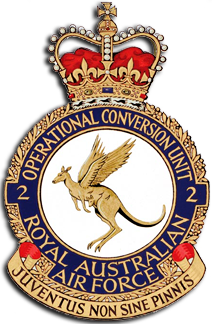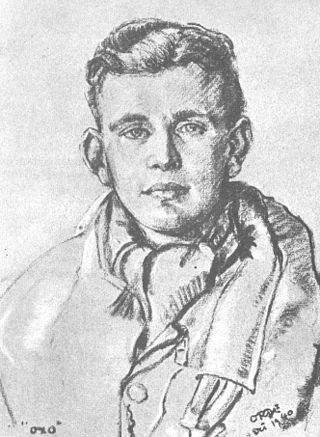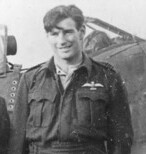
Air Vice Marshal James Edgar Johnson,, DL, nicknamed "Johnnie", was an English Royal Air Force (RAF) pilot and flying ace who flew and fought during the Second World War.

No. 75 Squadron is a Royal Australian Air Force (RAAF) fighter unit based at RAAF Base Tindal in the Northern Territory. The squadron was formed in 1942 and saw extensive action in the South West Pacific theatre of World War II, operating P-40 Kittyhawks. It was disbanded in 1948, but reformed the following year and operated jet aircraft throughout the Cold War. The squadron was based at Malta from 1952 to 1954, flying de Havilland Vampires, and Malaysia from 1968 to 1983, with Dassault Mirage IIIs, before returning to Australia.

No. 2 Operational Conversion Unit is a fighter training unit of the Royal Australian Air Force (RAAF). Located at RAAF Base Williamtown, New South Wales, the unit trains pilots to operate the Lockheed Martin F-35 Lightning II. Pilots new to the F-35 enter No. 2 2OCU after first qualifying to fly fast jets at No. 79 Squadron and undertaking initial fighter combat instruction at No. 76 Squadron. Once qualified on the F-35, they are posted to one of No. 81 Wing's operational F-35 units, No. 3 Squadron, No. 75 Squadron or No. 77 Squadron.

No. 452 Squadron is a Royal Australian Air Force (RAAF) air traffic control unit. It was established in 1941 as a fighter squadron, in accordance with Article XV of the Empire Air Training Scheme during World War II. The squadron flew Supermarine Spitfires for the entire war, initially over the United Kingdom and Nazi-occupied Europe. It was later based in Australia and the Netherlands East Indies, before being disbanded in 1945. It was re-raised in its current role in February 2011.

No. 78 Wing is a Royal Australian Air Force (RAAF) operational training wing, headquartered at RAAF Base Williamtown, New South Wales. It comprises Nos. 76 and 79 Squadrons, operating the BAE Hawk 127 lead-in fighter, and No. 278 Squadron, a technical training unit. No. 79 Squadron, located at RAAF Base Pearce, Western Australia, is responsible for converting new pilots to fast jets, while No. 76 Squadron at Williamtown conducts introductory fighter courses; both units also fly support missions for the Royal Australian Navy and the Australian Army.

No. 457 Squadron was a Royal Australian Air Force (RAAF) fighter squadron of World War II. Equipped with Supermarine Spitfire fighters, it was formed in England during June 1941 under Article XV of the Empire Air Training Scheme. The squadron was transferred to Australia in June 1942 and saw combat in the South West Pacific Area before being disbanded in November 1945.

Air Marshal Sir Harold Brownlow Morgan "Micky" Martin, was an Australian bomber pilot and senior commander in the Royal Air Force (RAF). He took part in Operation Chastise, the RAF's "Dambusters" raid in 1943, and was described by journalist Sir Max Hastings as "one of the three great bomber pilots of the war". He rose to become a senior officer in the RAF, commanding RAF Germany and later serving as Air Member for Personnel, a member of the Air Council, the RAF's controlling body.

Wilfred Stanley Arthur, was a fighter ace and senior officer of the Royal Australian Air Force (RAAF) during World War II. Commonly known as "Woof", he was officially credited with ten aerial victories. As a commander, he led combat formations at squadron and wing level, becoming at twenty-four the youngest group captain in the history of the RAAF.
No. 145 Squadron was a Royal Air Force squadron that operated during World War I, World War II and the Cold War.

Robert Wardlow Oxspring, was a Royal Air Force officer and flying ace of the Second World War.
No. 1 Wing was an Australian Flying Corps (AFC) and Royal Australian Air Force (RAAF) wing active during World War I and World War II. The wing was established on 1 September 1917 as the 1st Training Wing and commanded the AFC's pilot training squadrons in England until April 1919, when it was disbanded. It was reformed on 7 October 1942 as a fighter unit comprising two Australian and one British flying squadrons equipped with Supermarine Spitfire aircraft, and a mobile fighter sector headquarters. The wing provided air defence to Darwin and several other key Allied bases in northern Australia until the end of the war, and was again disbanded in October 1945.

No. 80 Wing was a Royal Australian Air Force (RAAF) wing of World War II. The unit was formed on 15 May 1944 and eventually comprised three squadrons equipped with Spitfire fighter aircraft. The wing's headquarters was absorbed into the newly formed No. 11 Group on 30 July 1945.

Air Vice Marshal Allan Leslie Walters, CB, CBE, AFC was a senior commander in the Royal Australian Air Force (RAAF). Born in Victoria and raised in Western Australia, he graduated from the Royal Military College, Duntroon, before transferring to the RAAF in 1928. He was one of the service's leading flying instructors and aerobatic pilots between the wars, and was appointed to his first squadron command in 1937. Over the course of World War II, Walters led No. 1 Squadron in Singapore, No. 1 (Fighter) Wing in Darwin, Northern Territory, No. 72 Wing in Dutch New Guinea, and Northern Command in Papua New Guinea. He was decorated with the Air Force Cross in 1941 for his work with No. 1 Squadron, and mentioned in despatches in 1944 for his service with No. 72 Wing.

Peter Jeffrey, was a senior officer and fighter ace in the Royal Australian Air Force (RAAF). Born in Tenterfield, New South Wales, he joined the RAAF active reserve in 1934, and transferred to the Permanent Air Force (PAF) shortly before World War II. Posted to the Middle East in July 1940, Jeffrey saw action with No. 3 Squadron and took command of the unit the following year, earning the Distinguished Flying Cross for his energy and fighting skills. He was appointed wing leader of No. 234 Wing RAF in November 1941, and became an ace the same month with his fifth solo victory. The next month he was awarded the Distinguished Service Order for his achievements, which included rescuing a fellow pilot who had crash landed in the desert.
Sir Alan Smith, CBE, DFC*, DL, was a British World War II Royal Air Force Supermarine Spitfire fighter ace and businessman.

Richard Cresswell, DFC was an officer and pilot in the Royal Australian Air Force (RAAF). He held command of No. 77 (Fighter) Squadron twice during World War II, and again during the Korean War. Cresswell was credited with being the first RAAF pilot to shoot down an enemy aircraft at night over Australian soil, the only man to serve as commanding officer of an RAAF squadron on three occasions during wartime, and the first officer to lead a jet-equipped Australian squadron in combat. His performance in Korea earned him both the Commonwealth and the US Distinguished Flying Crosses.

Alan Charles Rawlinson, was an Australian airman who became a fighter ace in World War II. He was credited with at least eight aerial victories, as well as two aircraft probably destroyed, and another eight damaged.
Owen Leslie Hardy was a Royal New Zealand Air Force (RNZAF) pilot flew combat sorties during the Second World War.

Robert Wilton Bungey was an Australian fighter pilot of the Royal Air Force (RAF) and later the Royal Australian Air Force (RAAF) during the Second World War. Officially, he was credited with five aerial victories and thus qualified as a flying ace but there is some uncertainty regarding this.

Raymond Thorold-Smith, was an Australian flying ace who served in the Royal Australian Air Force (RAAF) during the Second World War. He was credited with having shot down at least six aircraft.
















